PART A: Context for Digital Storytelling Project
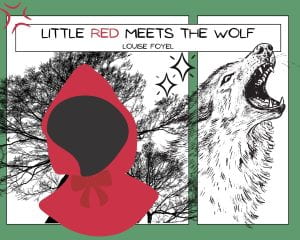
Little Red Meets the Wolf is a digital narrative that focuses on folklore and its origins. It was created in the style of a digital graphic novel and intertwines ICT and the NSW Stage 3 English Syllabus outcomes. As the Teacher Librarian, series like Amulet, Wings of Fire, Mythic and Raina Telgemeier’s books have soared in popularity. Year 6 has sourced the Heartstopper series outside of school too. The graphic novel style has been chosen to connect with Stage 3 students, because of the current popularity of this genre and the new experiences it is providing with reading in the 21st Century (Moorefield-Lang & Gavigan, 2012).
Little Red Meets the Wolf has been designed using Canva and can be shared with students via this platform and/or Google Classroom. It is intended for use nearer to the end of a unit about Folklore and Fairytales. Students will be familiar with the traditional versions of the story Little Red Riding Hood and its structural elements prior to being introduced to this resource, accessed via www.gutenberg.org, books in which copyright has now expired.
The protagonist in Little Red meets the Wolf is featured as a coloured image, as are other “good” characters. The rest of the narrative’s images are in black and white to show the contrast between “good” and “bad”. The music was added to create an atmosphere and emotional impact (Serafini et al., 2015) and the animations were added to provide the opportunity to interact with the text (McGeehan et al., 2018).

When engaging with this resource, students will:
- read through the given narrative in presentation mode (accessed via Google Classroom).
- engage in the comprehension tasks on each page. Part A (Image 2) is accessed via a clickable image. Answers are submitted via Google Classroom.
- open the Canva link (accessed via Google Classroom) and plan, compose and publish their own ending to the narrative (see Image 1, p6 and Image 3). Students are not required to make a copy as Google Classroom creates a copy for each student when shared as an assignment from Canva. Students must be aware of copyright (Image 1, p15).
Little Red Meets the Wolf Part A:
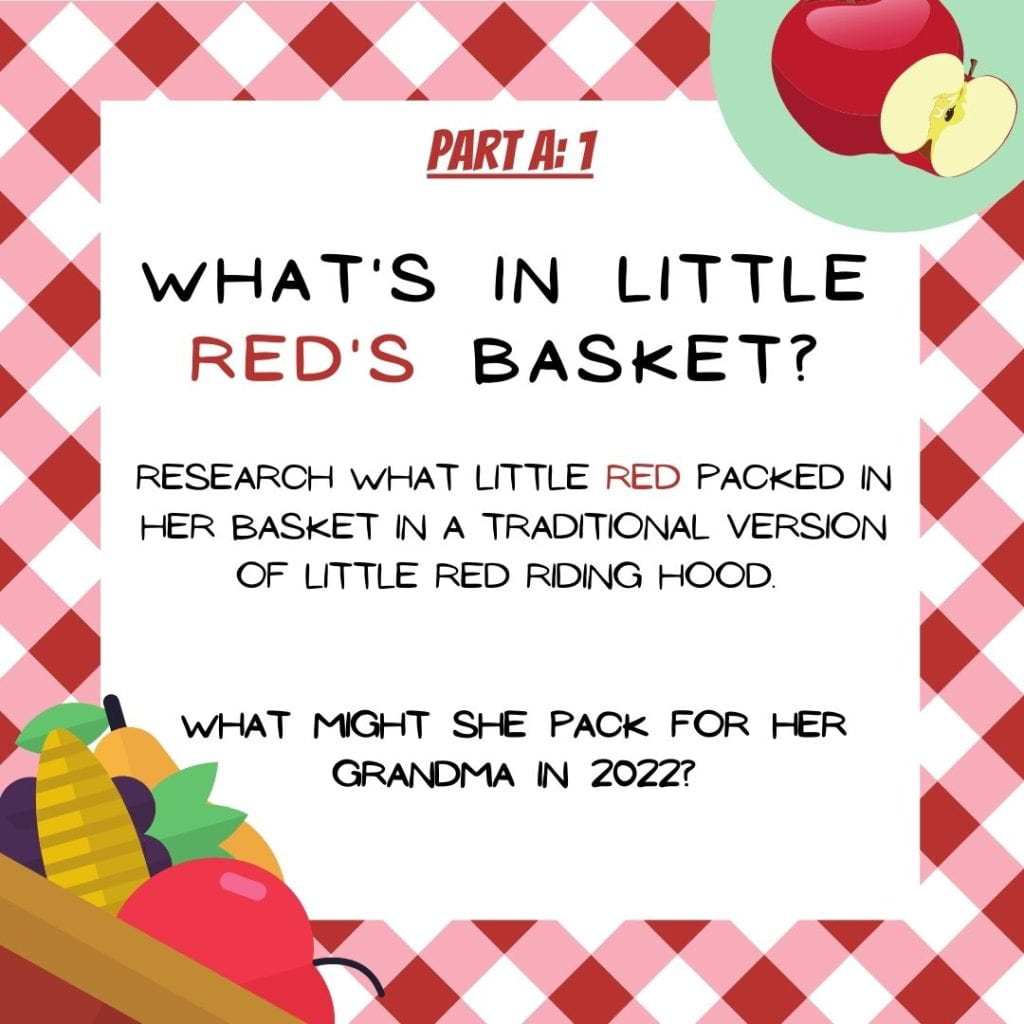
Page 3 Comprehension Task |
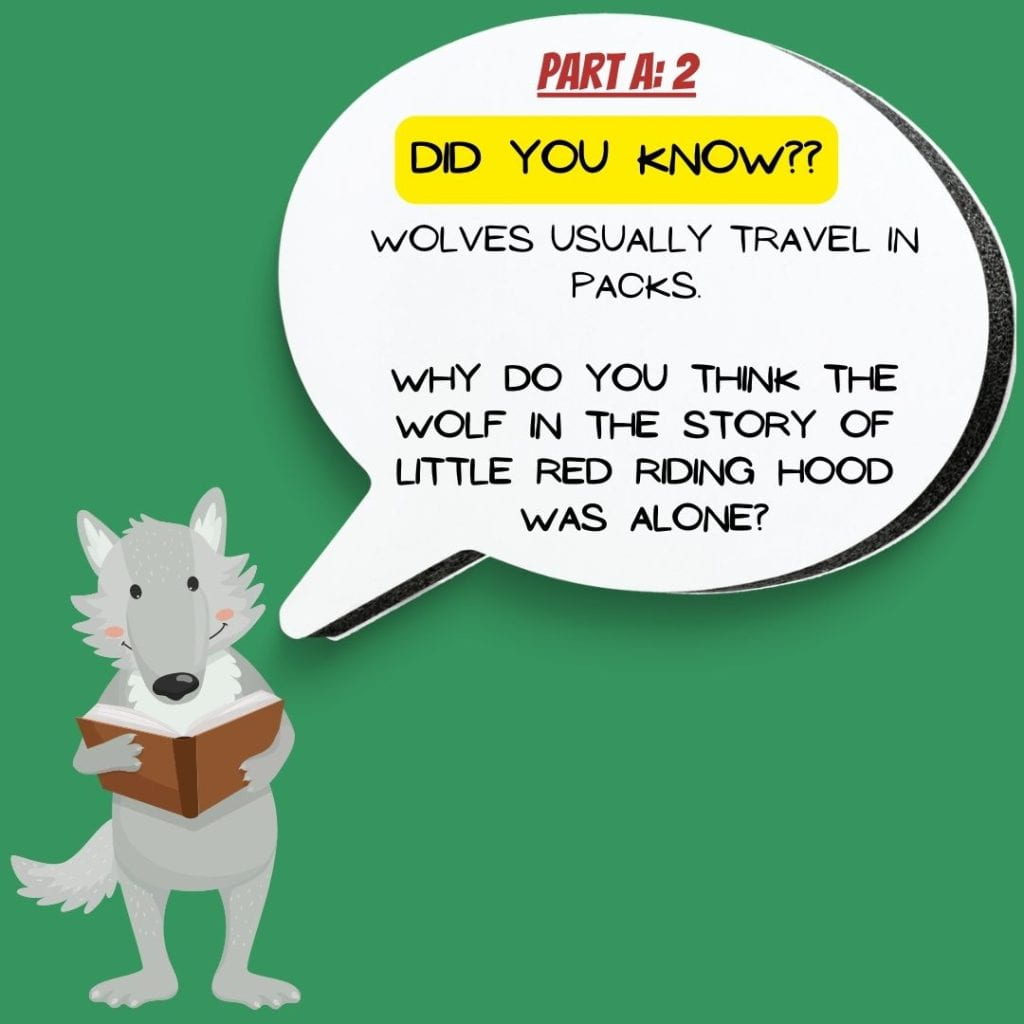
Page 4 Comprehension Task |
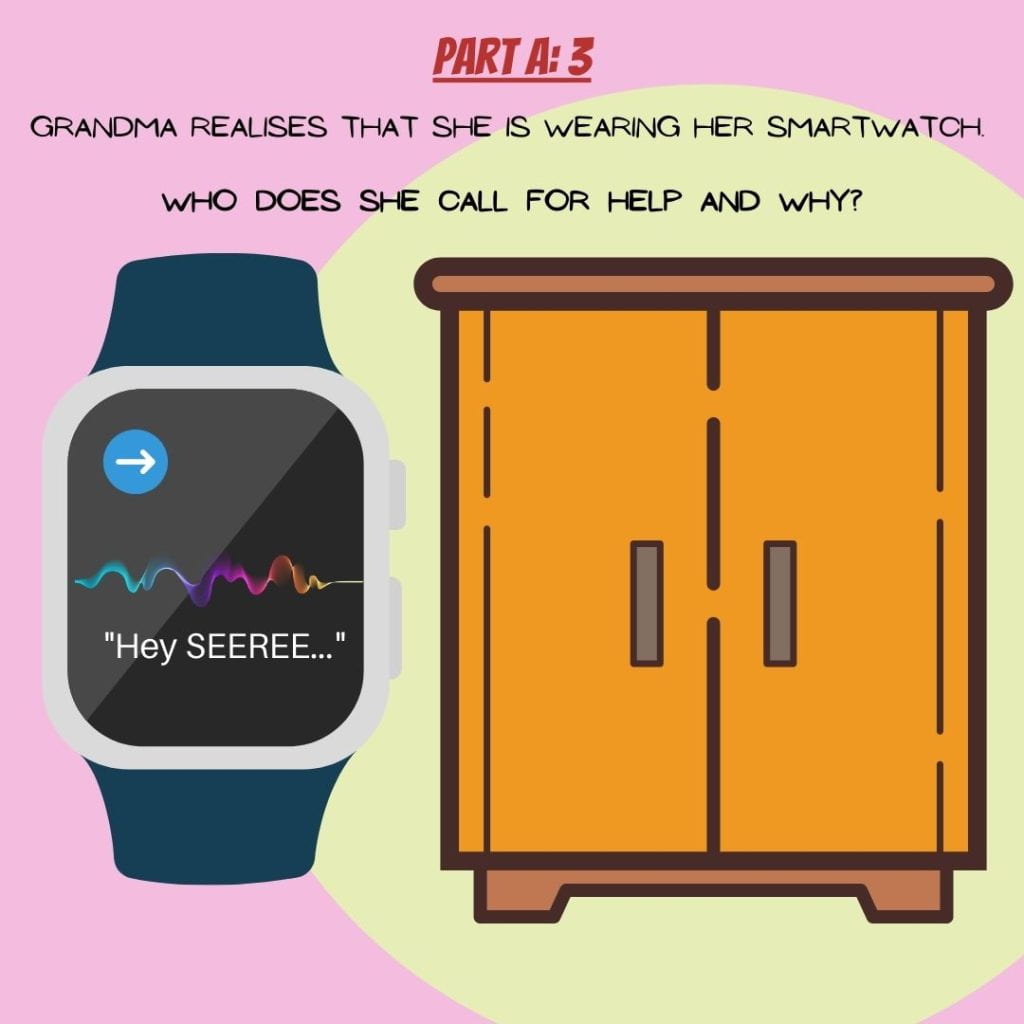
Page 5 Comprehension Task |
Image 2 (Foyel, L. 2022). Click on each image to enlarge.
Little Red Meets the Wolf Part B:
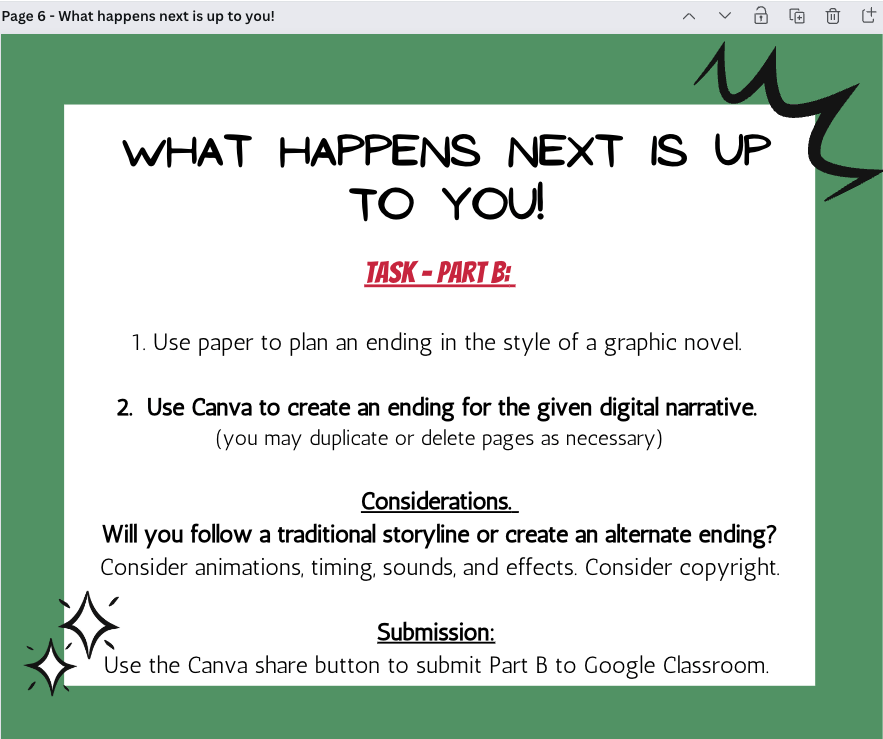
Students will share Part A comprehension tasks with their teacher and their peers of Stage 3. Likewise, students’ Part B digital stories will be shared with the same audiences.
As part of this development process, I road-tested this resource with Stage 3 students. Their feedback lead to some development changes to ensure that my target audience was well catered for. This included changing or adding dialogue, ensuring students could find the activities by adding the light bulb element and introducing the resource after reading the traditional Grimms tale and two other shorter adaptions for context.
Learning to manipulate the digital platform is one area for students to develop their ICT skills and support the digital narrative process (Fisher & Hitchcock, 2022). Students in Stage 3 at my current setting have one-to-one access to laptops and access to Canva via their student portal to engage with this resource.
Pages 7 – 11 (Image 1) of the resource are storyboard templates for students to use, ensuring the digital graphic novel style is incorporated and students learn about the new content format (Moorefield-Lang & Gavigan, 2012). These pages can be rearranged, duplicated or removed. Pages 12 – 14 (Image 1) are story elements such as background pictures, exclamation symbols, speech bubbles, and character elements to help with the design process and enhance consistency with students’ story conclusion. Students should understand that the graphic novel style intertwines both images and dialogue, and the two must coexist to create a comprehensible narrative (LaFille, 2022).
As part of the English curriculum, Stage 3 completes a writing unit on Folklore, Myths and Legends. This unit develops student knowledge, understanding and skills using the NSW English Syllabus (NESA, 2012) outcomes, particularly objective A outcome EN3-2A, objective B outcome EN3-6B, and objective C outcome EN3-7C. Combined with the NSW curriculum’s general capabilities, that “deepen students engagement” (NESA, 2022) through critical and creative thinking and digital literacy.
Teachers explore various traditional tales and the style that they use. Stage 3 teachers could use this resource to assess student learning. Assessing learner-generated digital stories can be a challenge, though having a generic design as this resource provides, helps to generate an appropriate marking rubric (Kearney, 2011). Alternatively, this resource could be used in library lessons to support learning in the classroom and allow for collaborative writing and content sharing (Malinta & Martin, 2010). Part A comprehension tasks extend student thinking and learning about this folktale, the origins of the tale and a 21st Century viewpoint. Part B task challenges them to think beyond the traditional tale and construct an alternative viewpoint. Ultimately, Little Red Meets the Wolf is a resource to engage and enthuse students and teachers and deepen their understanding of digital narratives (Dobler, 2013).
References (Part A)
Dobler, E. (2013). Looking beyond the screen: evaluating the quality of digital books. Reading Today, 30(5), 20 – 21.
Fisher, C. M., & Hitchcock, L. I. (2022). Enhancing Student Learning and Engagement Using Digital Stories. Journal of Teaching in Social Work, 42(4), 371–391. https://doi.org/10.1080/08841233.2022.2113492
Kearney, M. (2011). A learning design for student-generated digital storytelling. Learning, media and technology, 36(2), 169-188. https://doi.org/10.1080/17439884.2011.553623
LaFille, R (2022, February 26). Visual writing in graphic novels. Kids Comic Unite. [Blog post]. https://kidscomicsunite.com/visual-writing-in-graphic-novels/
McGeehan, C., Chambers, S., & Nowakowski, J. (2018). Just because it’s digital, doesn’t mean it’s good: Evaluating digital picture books. Journal of Digital Learning in Teacher Education, 34(2), 58-70. https://doi.org/10.1080/21532974.2017.139948
Moorefield-Lang, H. and Gavigan, K. (2012) These aren’t your father’s funny papers: The new world of digital graphic novels. Knowledge Quest, 40(3), 30-42.
NSW Education Standards Authority (NESA). (2012). English K-10 syllabus. https://educationstandards.nsw.edu.au/wps/portal/nesa/k-10/learning-areas/english-year-10/english-k-10/outcomes/table-of-objectives-and-outcomes
NSW Education Standards Authority (NESA). (2022). Learning across the curriculum: general capabilities. NSW Curriculum. https://curriculum.nsw.edu.au/teaching-and-learning/learning-across-the-curriculum#general-capabilities
Project Gutenberg. (n.d). Books: Little Red Riding Hood. https://www.gutenberg.org/ebooks/search/?query=Little+Red+Riding+hood&submit_search=Go%21
Serafini, F., Kachorsky, D. and Aguilera, E. (2015). Picturebooks 2.0: Transmedial features across narrative platforms. Journal of children’s literature, 41(2), 16-24.
PART B: Digital Storytelling Project
This resource has been created in its entirety using Canva. Canva allows a variety of ways to share this resource.
The link provided below is the presentation version, where you can advance at your own pace and click all links embedded in the presentation. All embedded links will open in a new window. Please note that music does not play automatically with all computers for this version and you may have to click a purple box in the top left corner to hear it.
There is also an embedded version, which would be used as the first play-through and advances automatically. This is not the version shared with students as the clickable links to the comprehension tasks do not work.
Little Red meets the Wolf : Presentation Link
Little Red Meets the Wolf by Louise Foyel
References (PART B)
Foyel, L. (2022). Little Red meets the Wolf. https://www.canva.com/design/DAFKUiigPvc/JsyCibvVdnTRHmCLyF4c2Q/view?utm_content=DAFKUiigPvc&utm_campaign=designshare&utm_medium=link&utm_source=publishpresent
Grimm, J. and Grimm, W. 1823 (2021). Grimms’ Fairy Tales. [eBook]. Project Gutenberg. https://www.gutenberg.org/files/2591/2591-h/2591-h.htm#link2H_4_0023
Lang, A. (Ed.). 1889. (2016). The Blue Fairy Book. [eBook]. Project Gutenberg. https://www.gutenberg.org/files/503/503-h/503-h.htm#link2H_4_0005
Perrault, C., 1889 (2010). Old-Time stories. [eBook]. Project Gutenberg. https://www.gutenberg.org/files/31431/31431-h/31431-h.htm#page92

